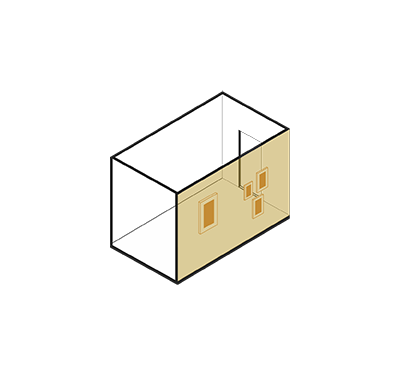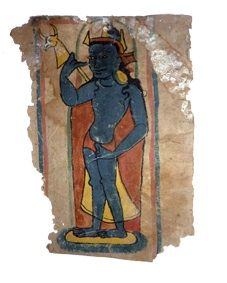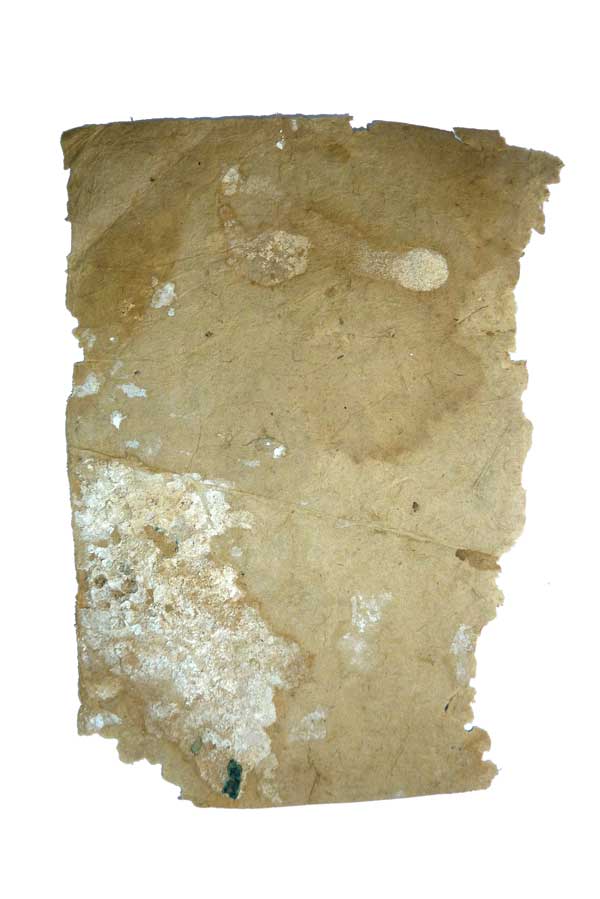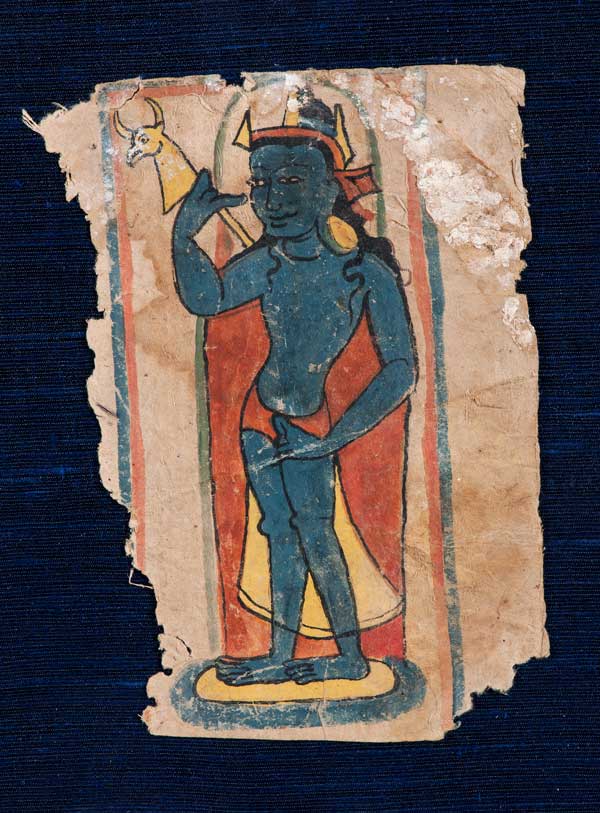Tibetan manuscript illustrated with the Bon po deity Khyung gi ru tsön chen
See it in the Museum

Aisle
Orientation 3
Wall object 5

ABM 030
Code: ABM 030
Country: Tibet (west)
Style: Purang-Guge Kingdom
Date: 1000 - 1100
Dimensions in cm WxHxD: 11 x 15.3
Materials: Distemper on paper
Bön Manuscript
This illumination from a manuscript shows the Bön deity named Khyung gi ru tsön chen (Tib. Khyung gi ru mtshon can). He is identified by the staff with the effigy of a horned khyung, which he holds in his right raised hand. The khyung represents a mythical bird identical to the Indian garuda bird.
In the history of Bön, three forms can be distinguished. The historically first form was an indigenous shamanic religion, which was largely replaced by Buddhism between the 8th and 9th centuries.
Although the followers of Bön were persecuted for several centuries with the establishment of Mahayana Buddhism as the state religion under Trisong Detsen from 755, Bön was able to reorganise itself in the 11th century and adopted the institutional organisation and terminology from Buddhism. But Bön retained its own ancient rituals and cosmogony. Thus, a second, syncretic form of Bön emerged. It had many similarities with Tibetan Buddhism, also in order to escape the royal prohibitions and to ensure the survival of the tradition. The third form includes diverse practices of folk belief, such as divination, which, while not Buddhist per se, are practised by both Bön-po and Buddhists. Despite the political persecution to which the Bön-po have fallen victim several times throughout history, the tradition survived. It can still be found in monasteries in eastern Tibet, in Nepal as well as in India, where Tibetan refugees have founded monasteries. Today, the Bön-po are recognised by the current Dalai Lama as the fifth school of Tibetan Buddhism, alongside the Geluk-pa, the Sakya-pa, the Kagyü-pa and the Nyingma-pa.
This illumination from a manuscript shows the Bön deity named Khyung gi ru tsön chen (Tib. Khyung gi ru mtshon can). He is identified by the staff with the effigy of a horned khyung, which he holds in his right raised hand. The khyung represents a mythical bird identical to the Indian garuda bird.
In the history of Bön, three forms can be distinguished. The historically first form was an indigenous shamanic religion, which was largely replaced by Buddhism between the 8th and 9th centuries.
Although the followers of Bön were persecuted for several centuries with the establishment of Mahayana Buddhism as the state religion under Trisong Detsen from 755, Bön was able to reorganise itself in the 11th century and adopted the institutional organisation and terminology from Buddhism. But Bön retained its own ancient rituals and cosmogony. Thus, a second, syncretic form of Bön emerged. It had many similarities with Tibetan Buddhism, also in order to escape the royal prohibitions and to ensure the survival of the tradition. The third form includes diverse practices of folk belief, such as divination, which, while not Buddhist per se, are practised by both Bön-po and Buddhists. Despite the political persecution to which the Bön-po have fallen victim several times throughout history, the tradition survived. It can still be found in monasteries in eastern Tibet, in Nepal as well as in India, where Tibetan refugees have founded monasteries. Today, the Bön-po are recognised by the current Dalai Lama as the fifth school of Tibetan Buddhism, alongside the Geluk-pa, the Sakya-pa, the Kagyü-pa and the Nyingma-pa.



